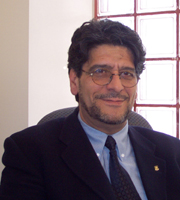
Professor Georgios Vatistas
Photo by Marc Boucier
|
by Janice Hamilton
If someone asked you to give an example of a vortex, you might suggest
a tornado, a whirlpool or water going down the bathtub drain. Or you might
come up with the vortex that appears on the wingtips of an aircraft, or
a hurricane, or a spiral galaxy, or the vortex produced by a mosquito’s
beating wings.
In fact, says Mechanical Engineering Professor Georgios Vatistas, vortices
(rotating liquids or gases) are “one of the rare phenomena that occur
across the spectrum of physics, varying from the extremely small –
a few angstroms (0.0000000001 metres) — to light-years (1,000,000,000,000,000,000
km) in size.”
Across this spectrum, vortices are similar, so a single mathematical model
should be able to describe them all. A model developed by the 19th-century
Scottish physicist and engineer William Rankine is still in use, but Vatistas
believes a model he developed at Concordia will eventually replace that
standard model.
“Rankine’s hypothesis suffers from a variety of physical contradictions
and inconsistencies,” he said. “The new theory, referred to
by others as the Vatistas Vortex Model, resolves all the difficulties.”
He says the latest model is mathematically simple and smooth, like nature,
and successfully describes the characteristics of velocity distribution
and pressure in strong vortices in mathematical computerized simulations.
Born in Greece, Vatistas came to Canada with his family at age 20 and
did all three of his degrees at Concordia, obtaining a PhD in 1984 with
a thesis on vortices in confined spaces.
“I used Rankine’s model, but I thought, there must be something
simple that would describe the physics better.” Eventually, after
much experimentation in the lab, and reflection, even while driving in
the car, he and a team of researchers came up with a new model, published
in 1991 in the journal Experiments in Fluids.
The first application appeared a short two years later in an American
paper on the aerodynamics of helicopter blades, and at least 19 citations
have appeared in graduate theses and scientific articles in the past 10
years, especially in the field of aerospace engineering.
Meanwhile, Vatistas has continued to improve the model. In a paper that
appeared in the American Institute of Aeronautics and Astronautics
Journal of Propulsion and Power in 1998, he broadened the model. Also,
the original model described a vortex in a state of permanence; he is
now ready to publish a paper that describes how a vortex decays, or changes,
over time.
Vatistas, who is also Associate Dean, Graduate Studies and Research, has
a variety of research interests, although he concentrates on fluid dynamics,
especially vortex dynamics, and their industrial applications. His studies
have included the behaviour of liquids sloshing around in tanker trucks,
the flow of blood through the abdominal aorta (a major vessel leading
to the heart) and the development of hardening of that artery, the behaviour
of vortices carrying sediments at the intakes of large water pumps, and
wind-tunnel testing for gas turbine engines.
Wide-ranging applications
His research has a broad range of other applications. For example, the
whirlpools and waves caused by vortices produce a lot of noise and vibration,
causing machinery to lose efficiency. Better understanding of these characteristics
will help designers improve machines.
Turbulence created by the takeoff of a large jet was blamed for the accidental
crash of the plane that followed it in the Queens borough of New York
City recently. “This new model contributes toward better calculations
of a safe separation distance between two aircraft,” Vatistas said.
Although his research will help industry, Vatistas is an academic at heart.
For him, “teaching is primary,” and research is the tool that
helps him be a better teacher.
|
|
|



